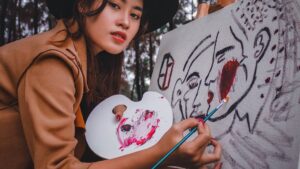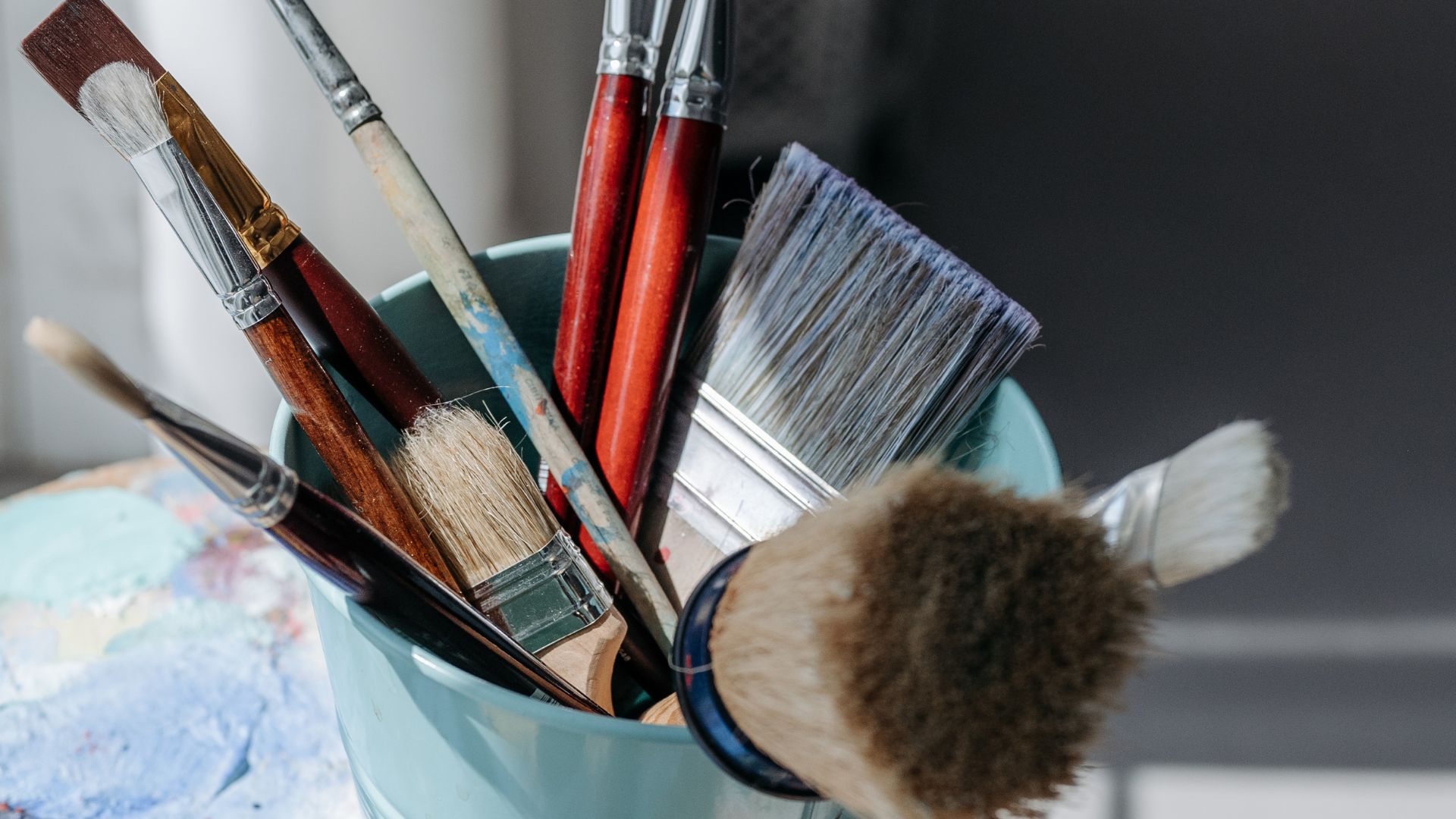Painting a mural on a cinder block wall can be an incredibly rewarding and transformative experience. To embark on this creative journey, there are several essential tools you’ll need to ensure a successful and visually captivating mural. Let’s dive into the key tools and materials required to bring your mural to life:
Tools for Preparing the Surface:
1. Pressure Washer:
Before painting, it’s crucial to thoroughly clean the cinder block surface. A pressure washer helps remove dirt, grime, and any loose particles, providing a clean canvas for your mural.
2. Masonry Primer:
Apply a quality masonry primer designed to adhere well to cinder block surfaces. This primes the wall, allowing the paint to adhere better and ensuring longevity.
Tools for Painting:
3. Paintbrushes and Rollers:
Different brush sizes and rollers will be your primary tools for painting the mural. Have a variety of brushes for intricate details and larger rollers for broad strokes.
4. Acrylic or Latex Paint:
Choose high-quality acrylic or latex paint suitable for exterior use. These paints are durable, weather-resistant, and offer vibrant colors.
5. Palette and Mixing Trays:
A palette for mixing colors and trays to hold different shades will assist in blending and creating the desired hues for your mural.
Additional Supplies:
6. Pencils, Chalk, or Markers:
Sketching the design onto the wall before painting helps plan the composition. Use pencils, chalk, or markers for outlining and defining the mural.

7. Ladder or Scaffolding:
Depending on the height of the wall, a ladder or scaffolding ensures safe access to all areas while painting.
8. Sealant or Varnish (Optional):
Applying a sealant or varnish over the completed mural can protect it from UV rays and weather elements, extending its lifespan.
Safety Gear:
9. Protective Gear:
Wear appropriate clothing, gloves, and safety goggles to safeguard yourself during the painting process.
External Resources:
For more in-depth information about mural painting techniques and materials, check out these helpful resources:
- The Ultimate Mural Painting Guide – MuralPainting.com offers detailed insights into mural painting techniques and materials.
- Tips for Painting Murals on Walls – Artist’s Network provides valuable tips and tricks for painting stunning murals on various surfaces.
- Choosing the Right Paint for Murals – Artist Supply Source offers guidance on selecting the best paints for outdoor murals.
Remember, each mural project is unique, so adapt these tools and materials based on the specific requirements of your design and wall surface. With the right tools and a dash of creativity, you’re all set to craft a breathtaking mural that captivates and inspires.
Moving forward
let’s delve deeper into the process of painting a mural on a cinder block wall. Apart from having the essential tools, understanding the steps involved and some pro tips can make a significant difference in the outcome of your mural:
Step-by-Step Guide:
1. Design and Planning:
Sketch your mural design on paper first. Consider the wall’s dimensions, surroundings, and lighting conditions. Once you have a clear design, transfer it onto the wall using pencils, chalk, or markers.
2. Surface Preparation:
Clean the cinder block wall thoroughly with a pressure washer to remove dirt, dust, and any debris. Allow it to dry completely before applying primer. Apply a coat or two of masonry primer to ensure good paint adhesion.
3. Mixing Paint and Test Colors:
Mix your paint colors in advance and test them on a small section of the wall to ensure they match your vision. Adjust colors as needed before starting the actual painting.
4. Start Painting:
Begin with the background or base colors, working your way from the top to the bottom. Use rollers for larger areas and brushes for finer details. Layer the paint to achieve depth and dimension in your mural.
5. Detailing and Refinement:
Once the base coat is dry, add details and finer elements to your mural. This is where your smaller brushes come in handy for intricate work. Take your time and pay attention to the finer details that bring your mural to life.
6. Finishing Touches:
Step back periodically to assess your progress and make any necessary adjustments. Ensure consistency in the overall look and feel of the mural. Allow the paint to dry completely before adding any protective sealant or varnish.
7. Protective Coating (Optional):
If desired, apply a protective sealant or varnish over the completed mural to enhance its durability and weather resistance.
Pro Tips:
- Blend Colors: Use a wet-on-wet technique to blend colors seamlessly, creating smooth transitions between shades.
- Layering: Layering different shades adds depth and realism to your mural. Experiment with transparent layers to create subtle effects.
- Step Back: Periodically step away from the wall to get a broader perspective of your mural’s progress and overall composition.
- Weather Considerations: Avoid painting in extreme weather conditions, as it can affect the paint’s drying process and quality.
External Resources:
1. Mural Painting Techniques – WikiHow offers step-by-step guidance on mural painting techniques suitable for beginners.
Comparison tabular
| Tools and Materials | Purpose | Importance |
|---|---|---|
| Pressure Washer | Cleaning the wall surface thoroughly | Removes dirt, grime, and loose particles to create a clean canvas |
| Masonry Primer | Preparing the surface for better paint adhesion | Ensures the paint adheres well to the cinder block surface, enhancing durability |
| Paintbrushes and Rollers | Applying paint to the mural | Essential tools for creating both broad strokes and intricate details |
| Acrylic or Latex Paint | Main painting materials | Durable, weather-resistant, and vibrant colors suitable for exterior surfaces |
| Palette and Mixing Trays | Mixing and holding different paint shades | Facilitates color mixing and easy access to various shades for the mural |
| Pencils, Chalk, Markers | Outlining and sketching the mural design | Helps transfer the design onto the wall for a clear outline before painting |
| Ladder or Scaffolding | Accessing different heights on the wall | Ensures safe access to all areas of the wall for painting |
| Sealant or Varnish | Optional protective coating for the completed mural | Enhances the mural’s longevity by protecting it from UV rays and weather elements |
| Protective Gear | Safety during the painting process | Protects against paint splatters, dust, and ensures personal safety during the project |
Wapping up
Embarking on a mural painting journey is an artistic adventure filled with creativity and expression. As you gather your tools and prepare to transform a cinder block wall into a captivating masterpiece, remember these final words:
Unleash Your Creativity:
Your mural is an opportunity to share your vision with the world. Embrace creativity, experiment with colors and techniques, and let your imagination guide each brushstroke.
Patience and Persistence:
Creating a mural takes time and dedication. Be patient with the process, and don’t rush the artistic journey. Persistence pays off in the form of a stunning finished mural.
Adapt and Enjoy:
Each mural project brings unique challenges and joys. Adapt to unforeseen circumstances, learn from the experience, and most importantly, enjoy every moment of the creative process.
Inspire and Connect:
A mural has the power to inspire and connect with the community. Share your art, spark conversations, and leave a lasting impression through your visual storytelling.
External Resources:
For ongoing inspiration and guidance, explore the wealth of resources available from experienced mural artists and painting enthusiasts:
- Mural Arts Philadelphia – Discover the transformative power of murals in communities and gain insights into mural painting techniques.
- Street Art and Graffiti Magazine – Explore diverse mural styles and stories from artists worldwide.
- National Endowment for the Arts – Murals – Learn about the significance of public art and its impact on communities.
Now, armed with the knowledge of essential tools, techniques, and a dash of inspiration, step forth with confidence and let your creativity adorn that cinder block wall with a mural that speaks volumes!

For over a decade, I’ve been Mike, an artist, crafter, and designer deeply immersed in the Croc world. I thrive on crafting unique, size-inclusive patterns, fostering creativity, and sharing them on ktforum.com. My designs aim to ignite your creative spark and delight you, ensuring clarity and ease of use through rigorous testing. Join me in expressing your creative flair and showcasing your craft with joy.
Related Posts
- Painting a Mural on a Cinder Block Wall: Adding Artistry to Outdoor Spaces
Outdoor walls, especially those made of cinder blocks, offer a fantastic canvas for artistic expression.…
- Guide to Choosing the Right Primer for Painting a Mural on a Cinder Block Wall
Whether you're an experienced muralist or diving into your first large-scale painting project, preparing a…
- Can You paint a mural on a textured cinder block wall
Painting a mural on a textured cinder block wall is not only possible but can…
- Painting a Mural on Damp Cinder Block Surfaces: What You Need to Know
When it comes to painting murals on surfaces like damp cinder blocks, there are a…

